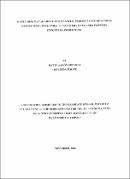Supply risk management and financial performance of flower export firms in Uganda: a case study of Uganda Flowers Exporters Association
Abstract
The study assessed the relationship between "Supply Risk Management and Financial
Performance of Flower Export Firms in Uganda: a Case Study of Uganda Flowers Exporters
Association". This was guided by the following specific objectives to; establish the relationship
between supply Risk Identification strategies on the financial performance of Flower export
firms, determine the relationship between supply risk measurement techniques on the financial
performance of flower export firms and to examine the relationship between supply risk
mitigations strategies on the financial performance of flower export firms. The methodology
adopted a case study research design. Data collected and used include both primary and
secondary data which was collected by use of self-administered questionnaires and an interview
guide. The findings of the study revealed there was a strong positive correlation between supply
Risk Identification strategies strategy and financial performance of flower export firms. The
study findings were that the supply risk management (supply Risk Identification strategies,
supply risk measurement techniques supply risk mitigations strategies) had a positive effect on
financial performance of flower export firms in Uganda. Failure to adequately identify supply
risks increased exportation flower risk which was found to be between (38%-51 %) in the period
2011 and 2013 of the sales volume exported to Holland, UK and Japan mainly. This
consequently reduced growth of revenue earning from exportation by 25% in the financial year
ended 2015/2016. Results based on made losses at a declining rate whereas from 2014 to 2015
losses hiked severely till 2016 with the root mean square value of 0.0192. The performance
graph also reveals the model relationship as Y= 26364x, this is the rate at which Uganda Flowers
Exporters Association makes losses per annum and regression trend line indicating, R2 = 0.0192.
The study concludes that, there is Relationship between supply Risk Identification strategies,
supply risk measurement techniques, supply risk mitigations strategies and financial
performance (r =. 0.303; p>0.035, <0.05). The study results therefore show that supply Risk
Identification strategies, supply risk measurement techniques supply risk mitigations strategies
have a positive effect on Financial Performance of Ugandan Flowers Exporters. This is
explained by the positive correlation co-efficient between the two variables (r = 0.303). Low
levels of supply Risk Identification strategies; supply risk measurement techniques supply risk
mitigations strategies make Financial Performance difficult for flower firms. There is a strong
relationship between supply Risk management and Financial Performance of flower export
1inns (r=.052; p>0.73, <0.05). 1t was concluded that supply chain risks affect organization
performance in the event they materialize and therefore there was need for organization to
identify risk exposure, analyze the risk exposure and have in place mitigation plans for the risk
identified within their supply chain. The study recommends that, there is therefore the need for
the Ugandan export industry to develop an integrated supply risk management system which
ensures a systematic and comprehensive approach to managing supply risks across the sector.
This makes the floricultural industrial activities to become more varied. Management will
therefore need a portfolio view of all the various supply risks and developing a strategy to
manage them with the view of benefiting from diversification effects. Such an integrated
approach can help senior management realize the relationships between the various supply risk
exposures as well as their multidimensional effect on the exportation sector. The study
suggests that further research should be conducted to investigate the relationship between Risk
Management and Entrepreneurial Development and examine how supply risk management
practices influence sales volume of Uganda's export industry.

